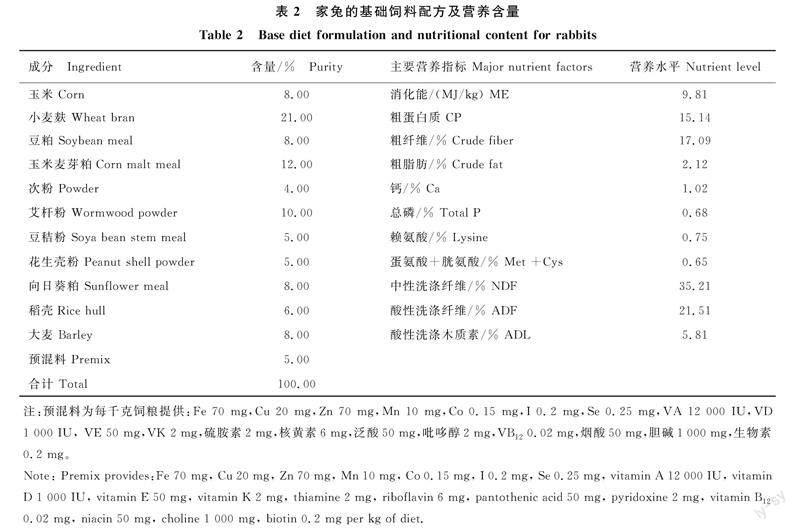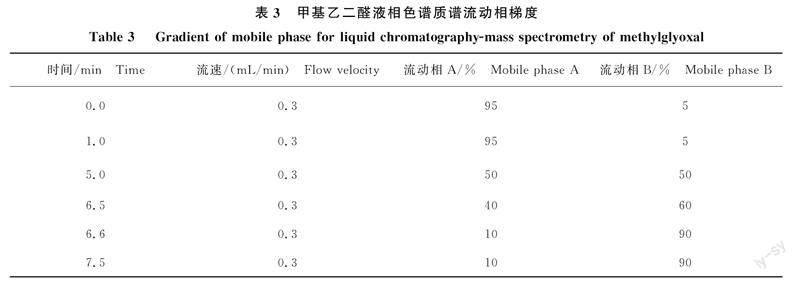鸡和兔血糖调节生理差异比较
罗舒文 胡璇 郑铭 徐雪雪 刘雪明 仲向前 张钰 陈国宏 徐琪



摘 要 为阐明禽类在高血糖情况下未表现出任何临床症状的内在原因,以鸡、家兔为研究对象,利用ELISA、高效液相色谱、液相色谱质谱检测等技术对两者葡萄糖调节生理差异进行比较。结果显示,ELISA检测鸡的糖化白蛋白显著高于兔,而糖化血红蛋白无显著性差异;鸡血清果糖胺含量与兔无显著性差异; 鸡血清终末糖基化产物含量极显著低于兔;高效液相色谱检测结果显示,鸡的牛磺酸含量和游离氨基酸含量显著高于兔;液相色谱质谱检测结果显示,鸡的甲基乙二醛含量与家兔无显著性差异。以上研究结果表明,鸡无慢性高血糖所表现出的有害效应的主要原因是牛磺酸和部分游离氨基酸作为羰基清除剂降低果糖胺及甲基乙二醛的含量,从而导致糖基化终末产物的降低。
关键词 鸡;兔;血糖调节;糖基化终末产物;糖化蛋白;牛磺酸;甲基乙二醛
就糖代谢而言,禽类是脊椎动物的一个独特的类别。因其有着明显的胰岛素抵抗[1],且血糖浓度很高,为哺乳动物的2倍左右[2-3]。这种血糖浓度长期处于哺乳动物的病理水平,但却无明显的糖尿病并发症状,是一种很好的研究糖尿病疾病的动物模型[4]。导致糖尿病并发症的主要因素之一是葡萄糖美拉德反应,美拉德反应实际上是糖的羰基与氨基酸、磷脂和核酸等生物分子的胺之间的多重反应。而糖与生物分子这两种化合物是生命必须的,且必须在细胞和生物体中共存,因此美拉德反应是不可避免的[5]。此外,由于美拉德过程的自发性、随机性和不可控性,且反应产物通常是有毒的,因此会显著导致糖尿病并发症和机体的衰老。简单来说,美拉德反应会导致形成多种产物,称为晚期糖基化终末产物(AGEs)。而AGEs对细胞和生物体功能有着致命伤害,是一类与葡萄糖毒性和糖尿病并发症相关的异常葡萄糖代谢物[6]。例如,AGEs通过蛋白质交联、基质成分修饰、血小板聚集、内皮功能障碍增加[7]、血管松弛缺陷和脂蛋白代谢异常加速动脉粥样硬化[8];AGEs通过诱导氧化应激和炎症反应,导致肾损伤或纤维化[9],加速肾脏功能障碍[10]等。综上所述,了解AGEs及其前体物的发生发展对于研究糖尿病并发症的内在机理有着重要作用。
Szwergold等[11]在前期研究发现禽类可作为II型糖尿病无病理模型的突破点在于低浓度的AGEs,这可能是由于禽类有着抗糖基化的特性,但并无数据支撑[12]。故本研究通过检测并比较禽类(鸡)与哺乳动物(兔)之间的糖尿病并发症相关指标,对鸡和兔血糖调节生理差异进行比较,以期探索禽类高血糖却无临床症状的内在原因,为控制人类的糖尿病并发症等问题提供新思路。
1 材料与方法
1.1 试验动物与样品采集
试验动物分别选用来自宿迁养鸡场、侯氏花鸟店的40 d体质量在2.5 kg左右的鸡(罗斯308)和150 d体质量在3 kg左右的家兔(新西兰兔),于扬州大学文汇路校区的养鸡房和养兔房进行饲喂,试验时间为2021年3月20日至5月2日。鸡与家兔分别重复6只,其中鸡采用地面平养,自由采食和饮水;兔采用层叠式笼养,乳头饮水器饮水,自由采食。肉鸡与家兔饲料由公司提供,二者基础饲料配方及营养水平分别见表1和表2。试验动物食入日粮中均无额外糖分添加。
两者饲养至体质量相近且均处正常生理状态时,对鸡和家兔利用脱氢酶电化学法使用罗氏血糖仪(罗氏AccuChekperforma卓越精采型,美国罗氏公司)进行空腹血糖(禁食8 h以上,不禁水)和餐后血糖(餐后2 h以内)水平检测;分别对鸡进行翅静脉采血、家兔耳缘静脉采血,血清采集步骤:采血于促凝管,静置30 min,3 500 r/min离心10 min后分装至1.5 mL EP管, -80 ℃保存,备用;全血及血浆采血至含肝素钠的抗凝管中,全血保存于-20 ℃,备用。血浆立即3 500 r/min离心10 min,随后分装至1.5 mL EP管, -80 ℃保存,备用。
1.2 糖化白蛋白、糖化血红蛋白检测
新鲜血液利用Elisa试剂盒(江苏科特生物科技有限公司提供)分别测定糖化白蛋白、糖化血红蛋白含量。
1.3 甲基乙二醛检测
将分离的血浆样品经0.22 μm有机滤膜,然后用Agilent 1290-6470液相色谱质谱仪测定甲基乙二醛含量。牛磺酸液相色譜质谱条件如下:色谱柱,Agilent C18柱(2.1 mm×100 mm,1.8 μm);柱温, 35 ℃,流速,0.3 mL/min;采集模式,ESI+;母离子,195;子离子,127、115;进样量,2 μL;流动相为A 0.1% 甲酸水溶液,B乙腈,流动相梯度见表3。甲基乙二醛含量按公式计算:
W=【(C-C0)×V×N】/m
式中:W表示试样中甲基乙二醛含量,单位为μg/L;C表示试样测定液中甲基乙二醛的质量浓度,单位μg/L;V表示定容体积,单位mL;N表示稀释倍数;m表示试样的取样量,单位为 mL。
1.4 果糖胺、糖基化终末产物检测
采用低速离心分离血清,利用Elisa试剂盒(江苏科特生物科技有限公司提供)分别测定果糖胺、糖基化终末产物含量。
1.5 牛磺酸、游离氨基酸检测
将分离的血浆样品经0.45 μm微孔滤膜,然后用Agilent 1260液相色谱仪测定。牛磺酸和17 个游离氨基酸标准品分别由广州佳途科技股份有限公司和上海源叶生物科技公司提供。牛磺酸液相色谱条件如下:色谱柱,C18 SHISEIDO柱(4.6 mm×250 mm×5 μm);检测器,FLD检测器;柱温,30 ℃;进样量,10 μL;波长,激发波长330 nm,发射波长530 nm;流动相,A为乙酸钠缓冲液,B为乙腈,流动相A∶流动相B=70∶30。
游离氨基酸液相色谱条件如下:色谱柱,C18 SHISEIDO柱(4.6 mm×250 mm×5 μm);柱温,40 ℃;进样量,10 μL;波长,254 nm;流动相,A为0.1 mol/L无水乙酸钠+乙腈=97+3,混匀后调pH至6.5(31.815 g乙酸钠+3 880 mL水+120 mL乙腈),B为乙腈+水=80+20;流动相梯度见表4。
1.6 数据处理与分析
采用Excel 2019建立数据库,利用SPSS 25.0软件对数据进行统计分析,采用单因素方差分析进行显著性检验,以P<0.05表示差异有统计学意义。用作图软件GraphPad Prism 8.0进行制图,数据以“平均值±标准差”的形式表示。
2 结果与分析
2.1 鸡与家兔的血糖、糖化白蛋白、糖化血红蛋白含量比较
对鸡和家兔的血糖(BG)、糖化白蛋白(GA)和糖化血红蛋白(HbA1c)进行测定。结果显示(图1),鸡和家兔的平均空腹血糖为11.283 mmol/L和5.617 mmol/L,平均餐后血糖为 11.983 mmol/L和7.267 mmol/L,鸡的餐前餐后血糖无显著变化,而家兔的血糖显著增加(P< 0.05);鸡的餐前餐后血糖均显著高于家兔(P<0.01)。糖化白蛋白测定结果显示,鸡GA的含量极显著高于家兔(P<0.01)。而糖化血红蛋白测定结果显示,鸡与家兔的HbA1c含量无显著差异(P>0.05)。
2.2 鸡与家兔的果糖胺、糖基化终末产物含量比较
通过ELISA法对鸡与家兔的
从这4个指标的检测结果可以看出,鸡的血糖在显著高于兔的前提下,鸡HbA1c的含量与家兔并无显著差异,GA和FA的含量略高于家兔,但总AGEs的含量鸡却显著低于家兔。说明鸡的血糖浓度虽然很高,致使检测短期糖基化的两个蛋白指标高于家兔,但长期监测的HbA1c指标并无显著差异。从另一角度而言,这意味着鸡的高血糖浓度可能并不会导致蛋白长期受糖基化的影响,这与Jessica等[29]的结果相一致。但糖化蛋白浓度究竟是如何随着时间的增长而降低的,其中原因不得而知,还需进一步研究。
3.2 鸡与家兔AGEs的含量与MG浓度差异密切相关
前人研究发现AGEs受体(RAGE)在AGEs的命运中扮演着消极的角色。AGEs与其结合会激活机体的应激反应,导致炎症和细胞功能障碍[30],因此RAGE基因被认为是糖尿病并发症发生的重要因素之一[11]。近年来研究发现禽类缺少RAGE基因[31],这是解释它们能成功应对高血糖并发症的能力之一。但从结果中可以看出,高血糖鸡的AGEs比家兔正常血糖下的AGEs还要低许多,说明缺少RAGE基因并非关键因素,因此寻找致使鸡血清低AGEs浓度的原因更为重要。
鉴于以上结果,本研究另外检测了两物种的甲基乙二醛含量。甲基乙二醛(MG)的产生与前面提到的蛋白糖基化相互关联,并相互影响:血糖浓度升高导致糖酵解生成MG[32];另一方面,葡萄糖通过互变异构生成果糖,果糖分解代谢后形成α-氧醛,MG即为其中之一[18]。MG是生成AGEs的重要前体物质,MG及其两个相邻的羰基可以直接形成AGE[33]。Brownlee等[6]发现在培养牛主动脉内皮细胞时发现,AGE含量的增加是由于甲基乙二醇产量的增加。此外据估计,MG的反应活性约是葡萄糖的20 000倍[34],且对细胞有着高度的毒性[35]。所以,动物体内MG的含量对糖尿病患者是否产生并发症发挥着重要作用。或许,鸡的AGEs的低含量是由于MG含量本就不高导致。但通过检测发现,鸡与家兔的MG并无显著差异,可能是由于鸡体内有某个物质或某些物质在MG后续形成AGEs的过程中起了调节作用。
3.3 鸡与家兔牛磺酸和部分游离氨基酸含量 比较
牛磺酸于18世纪首次从胆汁中被分离出,是动物机体内的条件性必需氨基酸[36]。它含有磺酸盐,但并无羧基,主要通过肝脏中的半胱氨酸的氧化及脱羧合成[37]。作为一种体内的氧化剂,牛磺酸可以对多种细胞功能进行调节,包括胆汁酸结合、防止由于氧化损伤引起的膜通透性变化等[38]。有研究报道,糖尿病患者的体内牛磺酸水平持续下降,而适当补充牛磺酸在胰岛素依赖、胰岛素抵抗[39]及糖尿病并发症方面有显著效果[40]。而本研究发现,对于体质量相近的鸡和家兔,鸡的牛磺酸含量显著高于家兔。这或许是鸡AGEs浓度低的关键:一方面,对于糖基化蛋白,例如糖化白蛋白过高的后果是红细胞脆性增加,而尽管鸡的糖化白蛋白含量较高,但有牛磺酸对细胞的形态和功能进行调节,才导致鸡尽管血糖高但并无明显的病理现象;另一方面,牛磺酸较其他氨基酸而言具有與醛基较高的反应活性[41],而醛基是AGEs合成所必须的,意味着牛磺酸可以直接抑制AGEs的形成。
此外已有研究表明,游离氨基酸除了有抗氧化的作用外,还可以作为羰基清除剂[42]。Siahbalaei等[43]研究发现游离氨基酸尤其是精氨酸、谷氨酸具有良好的抑制葡萄糖氧化的能力。但在机体的血浆糖基化含量较高的情况下,游离氨基酸含量会减少,其抗氧化活性亦会降低[44]。结果发现与家兔相比,鸡血浆中作为活性羰基清除剂的牛磺酸和其他游离氨基酸的浓度显著更高 (P<0.01)。家兔与鸡的甲基乙二醛差异并不显著,而游离氨基酸含量的检测结果可以解释这一原因:可能是由于进入血浆的MG会被精氨酸或其他清除剂中和。
4 结 论
本研究发现鸡有慢性高血糖却无任何临床症状的原因可能是牛磺酸和部分游离氨基酸作为羰基清除剂降低了果糖胺及甲基乙二醛的含量,从而导致糖基化终末产物的降低,抑制了其对生物机体的损害。这为探明禽类高血糖耐受生理特性提供了新的科学数据,也为人类防治Ⅱ型糖尿病及其并发症提供了新思路。
参考文献 Reference:
[1]王子阳,陈 文.鸡胰岛素耐受性及血液葡萄糖稳态调节研究进展[J].动物营养学报,2022,34(4):2123-2129.
[DW]WANG Z Y,CHEN W.Research progress in insulin tolerance and regulation of blood glucose homeostasis in chickens [J].Chinese Journal of Animal Nutrition,2022,34(4):2123-2129.
[2]李 慧,杨小军,姚军虎,等.蛋白酶和木聚糖酶对肉仔鸡生长性能、血液指标和消化机能的影响[J].西北农业学报,2011,20(1):45-51.
[DW]LI H,YANG X J,YAO J H,et al.Effects of protease and xylanase on performance,blood parameters and digestive function of broilers [J].Acta Agriculturae Boreali-occidentalis Sinica,2011,20(1):45-51.
[3]FRANSSENS L ,LESUISSE J ,WANG Y ,et al.The effect of insulin on plasma glucose concentrations,expression of hepatic glucose transporters and key gluconeogenic enzymes during the perinatal period in broiler chickens[J].General and Comparative Endocrinology,2016,232:67-75.
[4]BRAUN E J,SWEAZEA K L.Glucose regulation in birds[J].Comparative Biochemistry and Physiology Part B:Biochemistry and Molecular Biology,2008,151(1):1-9.
[5]HUEBSCHMANN A G,REGENSTEINER J G,VLASSARA H,et al.Diabetes and advanced glycoxidation end products[J]. Diabetes Care,2006,29(6):1420-1432.
[6]BROWNLEE M.Negative consequences of glycation[J].Metabolism-clinical & Experimental,2000,49(2 Suppl 1):9-13.
[7]ZHOU Z,WANG K,PENN M S,et al.Receptor for AGE (RAGE) mediates neointimal formation in response to arterial injury[J].Criculation,2003,107(17):2238-2243.
[8]RAJ D S,CHOUDHURY D,WELBOURNE T C,et al.Advanced glycation end products:a nephrologist's perspective[J].American Journal of Kidney Diseases,2000, 35(3):365-380.
[9]HUANG K H,GUAN S S,LIN W H,et al.Role of calbindin-D28k in diabetes-associated advanced glycation end-products-induced renal proximal tubule cell injury[J].Cells,2019,8(7):660.[ZK)]
[10][ZK(#]MATSUI T,HIGASHIMOTO Y,NISHINO Y,et al.RAGE-aptamer blocks the development and progression of experimental diabetic nephropathy[J].Diabetes,2017,66(6):1683-1695.
[11]SZWERGOLD B S,MILLER C B. Potential of birds to serve as a pathology-free model of type 2 diabetes,part 1:is the apparent absence of the RAGE gene a factor in the resistance of avian organisms to chronic hyperglycemia?[J].Rejuvenation Research,2014,17(1):54-61.
[12]SZWERGOLD B S,MILLER C B.Potential of birds to serve as pathology-free models of type 2 diabetes,part 2:do high levels of carbonyl-scavenging amino acids (e.g.,taurine) and low concentrations of methylglyoxal limit the production of advanced glycation end-products?[J].Rejuvenation Research,2014,17(4):347-358.
[13] YAMAGISHI S,MATSUI T.Advanced glycation end products,oxidative stress and diabetic nephropathy[J]. Oxidative Medicine and Cellular Longevity,2010,3(2):101-108.[ZK)]
[14][ZK(#]HSIEH C L,YANG M H,CHYAU C C,et al.Kinetic analysis on the sensitivity of glucose- or glyoxal-induced LDL glycation to the inhibitory effect of psidium guajava extract in a physiomimic system[J].Biosystems,2007, 88(1/2):92-100.
[15]BAKER J R,METCALF P A,JOHNSON R N,et al.Use of protein-based standards in automated colorimetric determinations of fructosamine in serum[J].Clinical Chemistry,1985,31(9):1550-1554.
[16]JOHN W G.Effect of schiff base (labile fraction) on the measurement of glycated hemoglobin by affinity chromatography[J].Clinical Chemistry,1984(6):1111-1112.
[17]CHO S J,ROMAN G,YEBOAH F,et al.The road to advanced glycation end products:a mechanistic perspective[J].Current Medicinal Chemistry,2007,14(15):1653-1671.
[18]SINGH R,BARDEN A,MORI T,et al.Advanced glycation end-products:a review[J].Diabetologia,2001, 44(2):129-146.
[19]LIN C H,LAI Y C,CHANG T J,et al.Hemoglobin glycation index predicts renal function deterioration in patients with type 2 diabetes and a low risk of chronic kidney disease[J].Diabetes Research and Clinical Practice,2022,186:109834.
[20]CHAHG H A,MIN S H,LEE D W,et al.Hemoglobin glycation index is associated with cardiovascular diseases in people with impaired glucose metabolism[J].The Journal of Clinical Endocrinology and Metabolism,2017,102(8):2905-2913.
[21] KUANG L,LI W,XU G,et al.Systematic review and meta-analysis:influence of iron deficiency anemia on blood glycosylated hemoglobin in diabetic patients[J].Annals of Palliative Medicine,2021,10(11):11705-11713.
[22] AYDIN B,ZCELIK S,KILIT T P,et al.Relationship between glycosylated hemoglobin and iron deficiency anemia:a common but overlooked problem[J].Primary Care Diabetes,2022,16(2):312-317.
[23] AHMED E,BOKHARY F E Z S,ISMAIL S,et al.Predictive value of the glycated albumin versus glycosylated hemoglobin in follow-up of glucose homeostasis in hemodialysis-maintained type-2 diabetic patients[J].Endocrine Regulations,2022,56(1):10-21.
[24]RUBENSTEIN D A,YIN W.Glycated albumin modulates platelet susceptibility to flow induced activation and aggregation[J].Platelets,2009,20(3):206-215.
[25]SINGH M,SHIN S.Changes in erythrocyte aggregation and deformability in diabetes mellitus:a brief review[J].Indian Journal of Experimental Biology,2009,47(1): 7-15.
[26]ADESHARA K A,DIWAN A G,JAGTAP T R,et al.Relationship between plasma glycation with membrane modification,oxidative stress and expression of glucose trasporter-1 in type 2 diabetes patients with vascular complications[J].Journal of Diabetes and Its Complications,2017,31(2):439-448.
[27]KLONOFF D C.Analysis:serum fructosamine as a screening test for type 2 diabetes[J].Diabetes Technology & Therapeutics,2000,2(4):537-539.
[28]JOHNSON R N,METCALF P A,BAKER J R.Fructosamine:a new approach to the estimation of serum glycosylprotein.An index of diabetic control[J].Clinica Chimica Acta,1983,127(1):87-95.
[29]JESSICA Z,BORGES C R,BRAUN E J,et al.Chicken albumin exhibits natural resistance to glycation[J]Comparative Biochemistry & Physiology Part B Biochemistry & Molecular Biology,2017,203:108-114.
[30]HUEBSCHMANN A G,REGENSTEINER J G,VLASSARA H,et al.Diabetes and advanced glycoxidation end products[J].American Diabetes Association,2006, 29(6):1420-1432.
[31]RAMASAMY R,YAN S F,SCHMIDT A M.Receptor forAGE (RAGE):signaling mechanisms in the pathogenesis of diabetes and its complications[J].Annals of the New York Academy of Sciences,2011,1243:88-102.
[32]SCHALKWIJK C G,STEHOUWER C D.Methylglyoxal,a highly reactive dicarbonyl compound,in diabetes,its vascular complications,and other age-related diseases[J].Physiological Reviews,2020,100(1):407-461.
[33]RABBANI N,THORNALLEY P J.Methylglyoxal,glyoxalase 1 and the dicarbonyl proteome[J].Amino Acids,2012,42(4):1133-1142.
[34]BEISSWENGER P J,HOWELL S K,RUSSELL G B, et al.Early progression of diabetic nephropathy correlates with methylglyoxal-derived advanced glycation end products[J].Diabetes Care,2013,36(10):3234-3239.
[35]THORNALLEY P J.Dicarbonyl intermediates in the maillard reaction[J].Annals of the New York Academy of Sciences,2005,1043(1):111-117.
[36]SIRDAH M M.Protective and therapeutic effectiveness of taurine in diabetes mellitus:a rationale for antioxidant supplementation[J].Diabetes & Metabolic Syndrome:Clinical Research & Reviews,2015,9(1):55-64.
[37]DAS J,ROY A,SIL P C,et al.Mechanism of the protective action of taurine in toxin and drug induced organ pathophysiology and diabetic complications:a review[J].Food & Function,2012,3(12):1251-1264.
[38]TIMBRELL J A,SEABRA V,WATERFIELD C J.The in vivo and in vitro protective properties of taurine[J].General Pharmacology,1995,26(3):453-462.
[39] ZHENGY,CEGLAREK U,HUANG T,et al.Plasma taurine,diabetes genetic predisposition,and changes of insulin sensitivity in response to weight-loss diets[J].The Journal of Clinical Endocrinology and Metabolism,2016(10):3820-3826.
[40]ITO T,SCHAFFER S W,AZUMA J.The potential usefulness of taurine on diabetes mellitus and its complications[J].Amino Acids,2012,42(5):1529-1539.
[41]OGASAWARA M,NAKAMURA T,KOYAMA I,et al.Reactivity of taurine with aldehydes and its physiological role[J].Chemical & Pharmaceutical Bulletin,1993, 41(12):2172-2175.
[42]CANTERO A V,PORTERO-OTIN M,AYALA V,et al.Methylglyoxal induces advanced glycation end product (AGEs) formation and dysfunction of PDGFreceptor-β:implications for diabetic atherosclerosis[J].The Faseb Journal,2007,21(12):3096-3106.
[43]SIAHBALAEI R,KAVOOSI G.In vitro anti-diabetic activity of free amino acid and protein amino acid extracts from four iranian medicinal plants[J].Iranian Journal of Science and Technology,Transactions A:Science,2020,45(2):443-454.
[44]TUPE R S,BANGAR N,DIWAN A,et al.Comparative study of different glycating agents on human plasma and vascular cells[J].Molecular Biology Reports,2020, 47(1):521-531.
Comparison of Physiological Differences in Blood Glucose Regulation between Chickens and Rabbits
LUO Shuwen1, HU Xuan1, ZHENG Ming1, XU Xuexue1, LIU Xueming1, ZHONG Xiangqian2, ZHANG Yu1, CHEN Guohong1 and XU Qi1
Abstract The fasting blood glucose concentrations of birds are about twice of themammals, and the birds have significant insulin resistance, but there is no significant diabetic complications, the reasons for the absense are unclear.In order to elucidate the intrinsic reasons for no clinical signs of hyperglycaemia inthe poultry, this study was conducted to compare the physiological differences in glucose regulation between chickens and rabbits using ELISA, high performance liquid chromatography and liquid chromatography mass spectrometry detection techniques.The results showed that glycosylated albumin was higher in chickens than in rabbits, while glycosylated haemoglobin was not significantly different; serum fructosamine levels inchickens were not significantly different from those in rabbits; and serum levels of advanced glycation end-products were significantly lower in chickens than in rabbits .The results of high performance liquid chromatography showed that the taurine content and free amino acid content of chickens were extremely significantly higher than those of rabbits; the results of liquid chromatography mass spectrometry showed that the methylglyoxal content of chickens was not significantly different from that of rabbits.In conclusion, the main reason forchickens to exhibite deleterious effects under the no chronic hyperglycaemiais that taurine and some free amino acids act as carbonyl scavengers to reduce the levels of fructosamine and methylglyoxal, and decrease the advanced glycation end-products.
Key words Chicken; Rabbit; Glucose regulation; Glycosylation end products; Glycated proteins; Taurine; Methylglyoxal
Received2022-09-29Returned 2022-11-17
Foundation item Jiangsu Modern Agricultural (Broiler) Industry Technology System (No.JATS [2022]163).
First author LUO Shuwen, female, doctoral student. Research area:chicken genetic breeding and reproduction. E-mail:santifay@163.com
Corresponding author XU Qi, male, Ph.D, professor. Research area:poultry genetics and breeding. E-mail: xuqi@yzu.edu.cn
(責任编辑:顾玉兰 Responsible editor:GU Yulan)
收稿日期:2022-09-29 修回日期:2022-11-17
基金项目:江苏现代农业(肉鸡)产业技术体系(JATS[2022]163)。
第一作者:罗舒文,女,博士研究生,研究方向为鸡的遗传育种与繁殖。E-mail:santifay@163.com
通信作者:徐 琪,男,博士,教授,研究方向为家禽遗传育种。E-mail:xuqi@yzu.edu.cn

